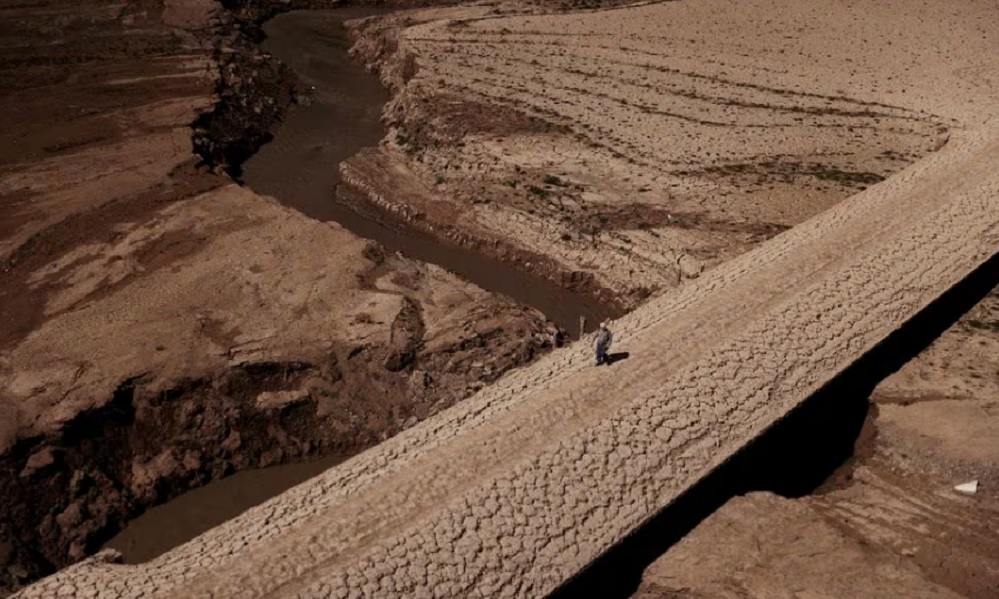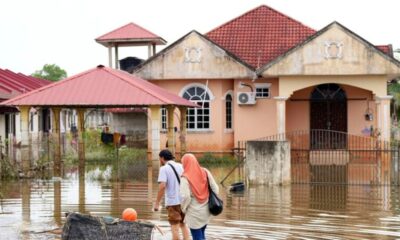Climate Change
US scientists say one-in-three chance 2024 another year of record heat

This year has a one-in-three chance of being even hotter than 2023, which was already the world's hottest on record, scientists from the U.S. National Oceanic and Atmospheric Administration (NOAA) said on Friday.
In its annual global climate analysis, the agency confirmed the findings of EU scientists that 2023 was the warmest since records began in 1850, putting it at 1.35 degrees Celsius (2.43 degrees Fahrenheit) above the preindustrial average. The amount of heat stored in the upper layers of the ocean also reached a record high last year, NOAA said, Reuters reported.
The World Meteorological Organization (WMO) also confirmed 2023 was a record year on Friday and said the world has warmed 1.2C (2.16F) above the preindustrial average, based on the ten-year global average temperature from 2014 to 2023.
The record was made possible by climate change, driven by the burning of fossil fuels, alongside an El Nino climate pattern that emerged halfway through the year. El Nino is a natural event that leads to warmer surface waters in the eastern Pacific Ocean and higher global temperatures.
It is expected to persist until at least April, increasing the likelihood 2024 will be another record year.
"The interesting and depressing question is what will happen in 2024? Will it be warmer than 2023? We don't know yet," said Christopher Hewitt, WMO head of international climate services.
NOAA said there was a one-in-three chance that 2024 would be warmer than 2023, and a 99% chance it would rank among the five warmest on record.
"It's highly likely (El Nino) will persist until April, possibly May, and then beyond that we're not sure — it becomes less certain," said Hewitt.
The impacts of El Nino normally peak during the Northern Hemisphere's winter and then diminish, switching to either neutral conditions or a La Nina phase which generally yields cooler global temperatures. But there is also the risk El Nino will return.
"If we were to make a transition into a La Nina phase ... maybe 2024 might not be the warmest on record," said Carlo Buontempo, director of Europe's Copernicus Climate Change Service.
As the Southern Hemisphere is now in summer when El Nino peaks, authorities are on alert for heatwaves, drought and fire.
This week, Australia's Bureau of Meteorology issued extreme heat alerts for Western Australia.
And in southern Africa, "we're really concerned about the potential for dry spells in January and February with a high likelihood of below-average rainfall," said Lark Walters, a decision support adviser for the Famine Early Warning System Network.
"We're estimating over 20 million will be in need of emergency food assistance."
Climate Change
Malaysia records six months of rain in just five days
One of the worst hit areas was Kelantan which recorded 1,442mm of rain between November 26 and 30

Six months worth of Malaysia’s average annual rainfall fell within five days across the east coast of the country last week, Prime Minister Datuk Seri Anwar Ibrahim said early Tuesday.
One of the worst hit areas was Kelantan which recorded 1,442mm of rain between November 26 and 30.
Ibrahim said the high rainfall led to flooding that forced a large number of people in Kelantan and Terengganu to be evacuated.
The recorded rainfall at Irrigation and Drainage Department stations in Tanah Merah and Tumpat, exceeded 1,167mm in just five days.
“According to the Malaysian Meteorological Department (MetMalaysia), the reading (in Kelantan) was at 1,442mm, an extraordinarily high level of rainfall. In Terengganu, MetMalaysia’s Besut station recorded 1,761mm of rain during the same period.
“Overall, the (average) rainfall was 1,349mm, far beyond our expectations,” Anwar told the Dewan Rakyat (Parliament) on Tuesday.
He also said the government is preparing for the forecast monsoon surge as announced by MetMalaysia, expected to start after Dec 8.
By Tuesday, some residents in the town of Tumpat were returning to submerged homes and shops as deadly floodwaters eased in some areas.
People who returned to their homes found many had collapsed, with parts of walls, roofs and broken furniture lying scattered in pools of water.
Muhamad Alim, a 56-year-old shopkeeper whose food store was inundated, recalled fast-rising waters in his home and his grandchildren crying as the flood surged on Saturday night.
"Electricity was cut off, and there was no water supply. So, we were stuck, sitting there as if we were in the middle of the sea, surrounded by water," he told Reuters.
"You could hear the sound of water rushing cutting through the silence of the night."
Six people have died in Malaysia and more than 150,000 were evacuated during the height of the floods last week, government data showed.
In Thailand, the death toll is 25, and more than 300,000 households were still affected, the interior ministry said.
The number of people in temporary shelters in Malaysia fell to just under 95,000 on Tuesday morning, though the authorities remain on guard for a second wave of floods this week.
Malaysia's Meteorological Department expects a wind convergence to begin on Tuesday, potentially bringing heavy showers, with a monsoon surge to follow on Dec. 8.
In Thailand, the Meteorological Department warned people in the south of the country to beware of heavy to very heavy rains and possible flash flooding and overflows from Dec. 3-5.
Climate Change
Malaysia and Thailand brace for second wave of heavy rain and possible flooding
Authorities say these have been the worst floods in decades, resulting in the death of at least 27 people across the two countries.

Malaysia and Thailand are facing a second wave of heavy rain and potential flooding this week, authorities said Monday following days of torrential rain that caused massive flooding in northern Malaysia and southern Thailand.
Authorities say these have been the worst floods in decades, resulting in the death of at least 27 people across the two countries.
Malaysia alone was forced to evacuate over 150,000 people on Sunday and rivers burst their banks and water levels steadily increased.
By Monday, authorities said the immediate situation had improved in some areas and water levels had eased but weather experts warned that more rain and possible floods were forecast again for Wednesday.
The northeastern state of Kelantan, which has been the worst hit, was also expected to face a fresh deluge from Wednesday, December 4.
Climate Change
NEPA chief reports back on Afghanistan’s attendance at COP29
Afghanistan is known for its vast mineral deposits, including lithium which is needed for batteries for the green transition

The head of Afghanistan’s National Environmental Protection Agency Mati-ul-Haq Khalis says comprehensive discussions were held at the recent COP29 summit on Afghanistan’s vulnerabilities to climate change.
He stated that the participation of IEA’s delegation at (COP29) marks a significant milestone, presenting a comprehensive and transparent overview of Afghanistan's current environmental and climatic conditions to the global community.
“During COP29, concerted efforts were made to emphasize that climate change and environmental challenges transcend political considerations,” Khalis said in a statement.
He said the delegation urged the international community to treat these issues as critical social and humanitarian concerns.
This was the first time that Afghanistan was able to send a delegation to the annual UN climate summit since the Islamic Emirate’s takeover in August 2021.
According to Khalis, the delegation meanwhile used the opportunity to emphasize the need for urgent implementation of effective mechanisms to combat adverse effects of climate change and called for the acceleration of financial assistance in this regard.
The IEA delegation also advocated for enhanced engagement, coordination, and collaboration among relevant stakeholders in the fight against climate change, and advocated for Afghanistan’s active participation in regional and international forums.
Khalis said Afghanistan’s representatives also stressed the urgency of resuming suspended environmental and climate-related projects, which are crucial for addressing the country’s climate challenges.
“By introducing Afghanistan’s national focal point for the Green Climate Fund, the delegation sought to garner international support for the effective governance and management of environmental projects within the country,” Khalis stated.
Milestone for Afghanistan
Last year, the COP28 conference was held in the United Arab Emirates, but the Islamic Emirate was excluded. However, this year, Azerbaijan authorities decided to include an official delegation.
Afghanistan remains one of the most vulnerable countries to climate change and also has major environmental challenges.
But some experts believe that the rationale in some quarters for engaging with Afghanistan on environmental policy is its potential for resourcing key minerals for the green transition - key to this being Afghanistan’s enormous lithium deposits.
Lithium has certain unique properties which make it very suitable as a metal for batteries needed for the green transition, an a Chinese company recently expressed interest in investing $10 billion in Afghanistan’s lithium resources in the south.
The Islamic Emirate stated that the lithium deal would generate up to 120,000 direct and many more indirect jobs in the country.
Afghanistan has long been known for its wealth of mineral resources and the Ministry of Mines and Petroleum estimates it may hold 60 million tons of copper, 2.2 billion tons of iron ore, 1.4 million tons of rare earth elements such as lanthanum, cerium and neodymium, and vast amounts of aluminum, gold, silver, zinc, mercury, and lithium.
-

 Latest News5 days ago
Latest News5 days agoPakistan’s First Lady: World should not dictate to IEA, but opt engagement
-

 World4 days ago
World4 days agoIran, Europeans meet to test diplomacy with Trump term looming
-

 Sport4 days ago
Sport4 days agoBangladesh trumps Afghanistan in first match of U-19 Asia Cup
-

 Latest News4 days ago
Latest News4 days agoCSTO calls for inclusive government in Afghanistan
-

 Latest News4 days ago
Latest News4 days agoSix countries refer Afghanistan’s women’s rights violations to ICC
-

 Latest News3 days ago
Latest News3 days agoOver 12,000 Afghans entered Brazil with humanitarian visas in last three years: UNHCR
-

 Science & Technology4 days ago
Science & Technology4 days agoAustralia’s under-16 social media ban sparks anger and relief
-

 Latest News3 days ago
Latest News3 days agoFormer German FM blames lack of US coordination for chaotic withdrawal from Afghanistan
























